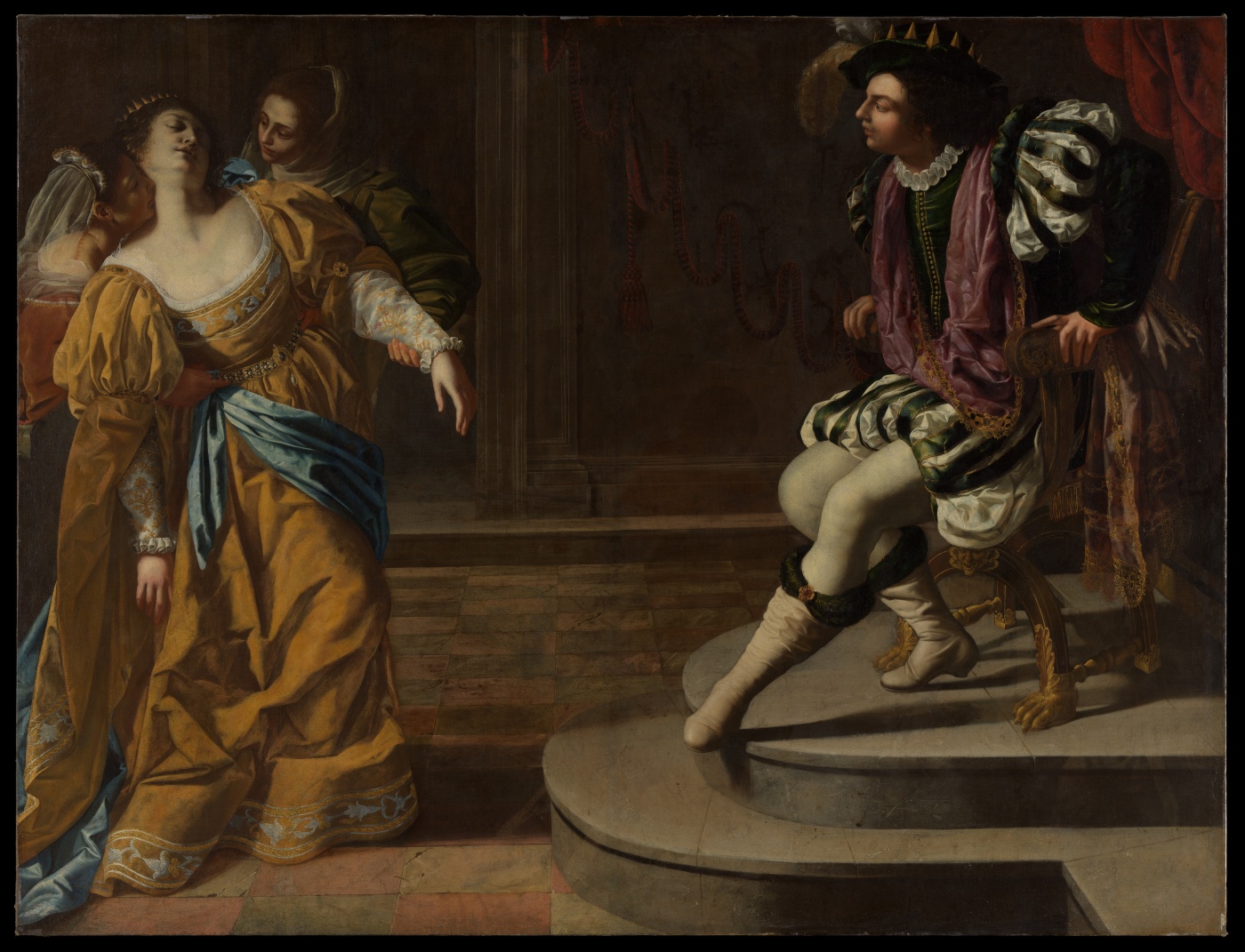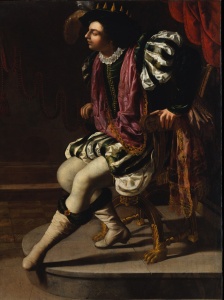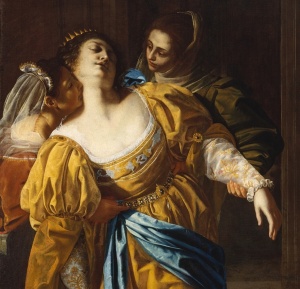Artemisia and Esther

Whether it is Purim or not, it’s always a good time to see Artemisia at the Metropolitan Museum of Art. Artemisia Gentileschi is the artist who painted Esther before Ahasuerus. And who exactly is this Artemisia Gentileschi? Why, she is the most famous, and perhaps only, serious woman painter of 17th Century Italy. And for a non-Jew she did have a curious interest in Jewish women. Let me explain further.
She was the very talented daughter of Orazio Gentileschi, who was a rather well known follower of the revolutionary Baroque painter, Caravaggio (1571-1610). Caravaggio represents the consummate example of the Italian Baroque style of painting characterized by the stark use of light and dark to tell dramatic Biblical (mostly Christian) stories. Most of these paintings were done for the Italian nobility and of course, the church. Orazio taught his daughter well and she grew up to be at least as good a painter as he was. He allowed her to work with him on various early projects and, until recently, her work was confused with his. Still, she was a woman in a male dominated world of Italian art and patronage and faced endless discrimination and struggle as a woman artist.

One early event in her life may be seen to have set the tone of much of her life’s paintings. When she was eighteen she was raped. The rapist was accused and there was a trial during which she was tortured to determine the veracity of her testimony. She was vindicated, and in fact was married off soon after. But, as one might guess, her reputation was tainted for the rest of her life. By examining her paintings we can see how she fought back against these traumatic events.
There are only thirty-four of her paintings that survive today and upon reviewing their subjects a startling fact emerges. The majority of the subjects are of women in Christian, mythological or allegorical subjects. That is not surprising. But of those paintings, at least a third of them are of Jewish women heroines. This choice, for her time, was rather unusual. And in fact the place where Artemisia finds her most convincing, strong and vibrant women is always in the Hebrew Bible and the midrashim. Susanna and the Elders (a non-Jewish subject from a Hebrew source), Judith Slaying Holofernes, David and Bathsheba, Jael and Sisera and finally, our painting at the Metropolitan, Esther before Ahasuerus, painted in 1622.
This very large painting, almost seven by nine feet, is deceptively simple. On the right side there is Ahasuerus seated on his throne on a raised platform. He is depicted as a rather dandy young king, very stylish as he is about to arise in alarm as Esther swoons before him. Esther is depicted on the extreme left side being supported by two handmaidens. Nowhere in our text of Esther is there any mention of her swooning before the king. But this incident at the beginning of Chapter five is depicted in the midrash and is also retained in the Catholic version.

Artemisia has treated this midrashic swoon in a very creative and unusual manner. Esther’s arm is extended out, almost pleading for the king to assist her. Her “artful” collapse is well calculated. While she might seem vulnerable to this dandy king (that depiction itself is telling), she is in fact very much in control of the situation. Her head is tilted back at an angle, her eyes closed and eyebrows arched in theatrical abandon. Until we notice that only one knee has given way to throw her off balance we might have thought she would soon end up on the floor in a heap. She originally swoons out of abject fear of the king’s anger (remember, she approached the king without permission) and yet has turned this into a way of controlling him, manipulating him and actually causing him to rise in her presence. Artemisia has found a singular place in the story of Esther where a mere woman can control events normally quite beyond her. And perhaps she is even alluding to Jacob’s submissive and manipulative encounter with the treacherous Esau, our own paradigm of dealing with powerful enemies.
This richly painted masterpiece is stark in its extremely simple composition and dramatic lighting and yet pays wonderful attention to myriad details. The lush fabric of Esther’s gowns and jeweled belt are matched and echoed by the shimmering satin and gold laced robes of the king. And then we notice the bottom of king’s throne is decorated with a fiendish head, undoubtedly the symbolic presence of Haman. Artemisia has thought of everything.
Artemisia Gentileschi found a way as a woman artist to protest the unfair treatment of women in the 17th century and the brutality of her rape and the attendant trial. Her source of strength and the substance of her resistance was in the courage of great Jewish women. She painted them with verve and insight, frequently providing psychological depth and tension to women caught in situations where they were forced to act decisively.
The insight of Artemisia into Esther and other Jewish heroines shows the enormous richness and depth of our Tanach for Jews and non-Jews alike. Her decision to paint these controversial subjects as a way of commenting on and shaping her world should give us courage to feel free to appropriate our own heritage and use it as part of our creative and artistic expression today. She believed that making paintings from our Tanach was a meaningful way communicate about everyday life. Is it any less true today?